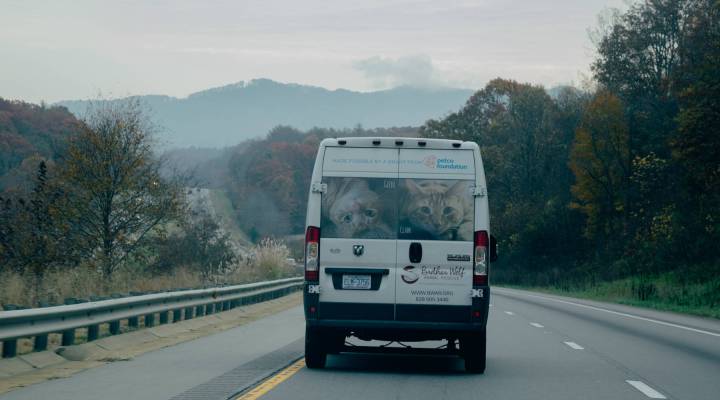
What rescue puppies teach us about supply and demand

This story was produced in partnership with Topic, a film, television and digital studio. For more information and to check out pictures of the dogs along the journey, go to Topic.com.
For Joy Harklerode, it started with a call at church. A friend had found something.
“A little week old puppy that was thrown away,” Harklerode said, now cradling the small black ball wrapped in a towel. “In a trash bag with her six siblings.”
This is a typical day for Harklerode. Sometimes, she gets up to 60 such calls a day. From sheriff’s deputies. From the trash guy. From an informal network of people who know she rescues dogs in Marion, North Carolina.
So, a dog in the trash, that’s life for Harklerode. And it’s where our story begins.
Part I — Why are there so many dogs?

A group of newly born puppies in Rutherford County, North Carolina.
This is a story about supply and demand. It’s also a story about dogs. And the story of an industry that’s sprung up: Moving a supply of adoptable dogs from the rural south to cities in the north, where there’s a demand for them.
On a recent Sunday, Harklerode sits with her friend Susan Menard, in Menard’s kitchen. Three dogs run around their feet. Harklerode holds the small black puppy. A disabled former nurse, she now uses her skills to care for animals, as the head of Mercy Fund Animal Rescue.
Harklerode rescues dogs from high-kill shelters and cares for strays and abandoned dogs from the community.
“There’s no spay-neuter law, no leash law,” Harklerode said. “We’ve tried for years to get one.”
That’s where the hunters come in. They’re a powerful group in rural North Carolina.
“We typically do not spay and neuter our dogs,” said Keith Loudermilt, president of the North Carolina Sporting Dog Association. “I don’t have a problem with spay and neuter, but when those regulations infringe on our sport and what we do, then we can’t give ground on this.”
Loudermilt said it’s an economic issue, too. Spaying and neutering costs money. Some North Carolina counties have proposed spay-neuter laws that would allow people to buy licenses that would exempt them from the rule. Loudermilt says that would add up, too. He owns 20 beagles.
Harklerode said the area’s hunting culture makes attempts for a spay-neuter law difficult.
“They don’t want any of these things instituted,” Harklerode said. “The county commissioners, they’re not in agreement that we need a spay-neuter law.”
Across town, Ashley Wooten is the McDowell county manager. He said spaying and neutering isn’t a part of the culture in the area. Plus, when the idea of such a law comes up, hunters don’t like it.
A lot of people think it’s government overreach, too, said Wooten. But, maybe more importantly, it’s a major expense in an economically depressed area.
“When you have the poverty level that we do and you have a working-class community like we do, it’s harder for folks to say, ‘OK, I’m gonna go out and spend $300 for this whatever procedure that my dog needs or my cat or to spend a $150 on a spay and neuter,’” Wooten said.
Instead the area’s focused on education, low cost vet services and bringing the euthanasia rate down at the county shelter.
That also means that in McDowell County — and across North Carolina — there’s an entire network of people like Joy Harklerode.
Rusty’s Legacy, a nearby volunteer rescue in Marion, houses 32 dogs in kennels. Some will live out their lives here. Others will head north.
On an overcast Monday morning Kelly Brown arrives at Rusty’s Legacy to collect dogs that will eventually reach the Connecticut Humane Society.
Brown is from Brother Wolf Animal Rescue, an animal rescue located in Asheville, North Carolina. She loads four cream and white hound puppies, plus one brindle, into crates. Vicki Harper, of Rusty’s Legacy, helps.

(Left to Right): Kelly Brown holding two puppies at the Brother Wolf Animal Rescue in Henderson County, North Carolina; Spare dog kennels outside of the Brother Wolf Adoption Center in Asheville, North Carolina; A pitbull terrier dog in his kennel at the Brother Wolf Adoption Center in Asheville, North Carolina.
“You have a new exciting life ahead of you,” Harper coos to the departing dogs. “Yes you do!”
The puppies — all of whom have names that start with Z — drive with Brown to Brother Wolf’s building in Asheville.
There, they get a vet check. And shots. The puppies squeal.
Brother Wolf has been transporting dogs north for roughly a decade, no small feat considering the costs involved. This year, they’ve moved more than 650 dogs. Connecticut state law requires medical checks before dogs enter the state. The checks cost about $200 for each dog.
After their vet checks are done, the staff load the dogs back onto the van. It’s an hour and a half journey to Taylorsville, North Carolina, their next stop.
Part II — The Transporter
Inside a bright white sprinter van, the dogs sit in crates. It’s their third van of the day.
They’ve just arrived from Asheville. The next step? Head north to the Connecticut Humane Society. Getting the dogs there is the job of two women: Kelly Ivory and Jane Hurst.
They run Howl on Wheels Transport, a ground transport service for rescued dogs.
On that overcast and foggy Monday night, they’ll drive like they always do. Overnight. Straight from North Carolina to Connecticut.
With the slam of a door and the rev of an engine, the transport heads out into the evening. It’ll be a long trip — 13 hours.
Ivory’s used to it, though. This has been her full-time job for five years.

Kelly Ivory and Jane Hurst of Howl on the Wheels, before their overnight drive from Saint Pauls, North Carolina to Newington, Connecticut.
“We’re going to be driving, and while one’s driving the other one’s going to be sleeping,” Ivory said. “If there’s any messes in the back, whoever’s not driving is cleaning it up as it happens,” she said with a hearty laugh.
An average week for Ivory could be 5,200 miles on the road, spent with her colleague and a load full of dogs. Ivory typically transports about 28 dogs at a time. She loads crates of dogs onto purpose-built shelves in her van, a modified she made herself.
Before Ivory became a transporter, she ran a humane society in southern North Carolina. As she rescued dogs from local high-kill shelters, she decided she needed to get dogs out of the area, so she turned north.
Ivory began occasional trips to deliver dogs to New York, Connecticut and Massachusetts. Every time she went, she said, other humane groups would ask her to take some of their dogs, too.
“So I went ahead and got a van,” Ivory said. “And decided that this is what I need to do.”
An hour into the trip, the women stop — it’s time to grab something to drink. Luckily, it’s finally quieted down in the back.
“We’ve had some dogs that just settled down,” Ivory said. “We’ve had to clean a few crates, but we are ongoing.”
For Ivory, the job is largely a labor of love.
She charges the receiving shelters $1 per mile, round trip. Ivory will charge about $1,600 for this 1,600 mile trip. She charges based on the fuel, her payroll costs and maintenance, which is the major cost to transporters. Ivory said she spends about $800 to $1,600 a month in maintenance costs from oil changes, rotating tires or, even the occasional late night run-in with a deer.
“There’s not a lot of money-making in transporting,” Ivory said. “I make ends meet but that’s pretty much it.”
At 1 a.m., another stop to get some fuel, use the restroom and grab snacks — and clean any crates that need to be cleaned.
As Ivory slides open the sprinter van’s door, dogs wake up and sleepily bark.
“Hi baby! Who’s a big baby? Look at you!” said Ivory, talking to a dog. “Oooooh yes, you made a mess in there. Hold on, we need paper towels!”
Ivory and Hurst get to work spraying down crates and cleaning dogs. It’s all part of the job.
“We have scheduled stops so we said we will stop. We will walk a dog, we will clean up their kennels,” Ivory said. “So by the time that we arrive up in the northeast you can open up the door and you don’t typically smell anything.”
And then, back on the road.
By 6:30 a.m. the white sprinter van is sitting in traffic outside of New York City, getting ready to cross over the Tappan Zee bridge. Most of the dogs are asleep.
Since starting out in the business, Ivory has seen the competition increase. She’s no longer the only one making these trips to northern animal shelters. She is now one of 18 animal carriers in North Carolina registered with the U.S. Department of Agriculture. There are 522 carriers actively registered with the USDA nationwide.
An industry has been born.
At about 9:30 a.m., the sun is fully up in the sky, “Small Town” by John Mellencamp plays over the radio while the dogs continue sleeping. The Connecticut Humane Society looms into sight.
“A lot of these dogs don’t deserve what they’ve been dished out,” Ivory said. “If I can be that leg of transportation up to the north, then I’m going to do it.”
Ivory pulls into the parking lot and cuts the radio. She’s arrived at the humane society with the dogs.
But they’re not home. Not quite yet.
Part III — Up North

Rhi Banks, an employee of the Brother Wolf Adoption Center, holds a puppy as they prepare for their overnight journey from North Carolina.
To understand why there’s a demand for dogs in the north in the first place, we need to step back in time.
Gordon Willard is the executive director at the Connecticut Humane Society, where the dogs have just arrived. He’s been in the business since 1983. Back then, animal shelters had more animals than they could adopt out.
“We were dealing with surplus animals,” Willard said. “We had oversupply and under demand.”
In 1987, the Connecticut Humane Society received over 40,000 local animals annually. But by the mid-90s something changed — all of a sudden, there were fewer homeless dogs.
“Spaying and neutering was working,” Willard explained.
New rules across New England made owners sterilize their pets. But just as fewer dogs got to shelters – demand for them shot up.
Why? Well a few reasons.
One, spay and neuter rules meant fewer people adopting out unwanted litters. Two, it also meant fewer strays. And three, awareness increased around puppy mills and animal welfare.
“And the word rescue took on a different connotation,” Willard said.
Then, Hurricane Katrina hit. In 2005, northeast humane organizations pooled resources to transport dogs from New Orleans. It showed them that transporting dogs from other places was possible, disaster or no.
By 2016, Connecticut organizations were bringing up about 20,000 animals a year from the south.
Today, about one in every ten comes to the Connecticut Humane Society, where the Howl on Wheels transport has just arrived.
With a chatter of “good mornings,” staff and volunteers get ready. Everyone dons bright blue scrubs.
There’s a whole process to this with set rules. The U.S. Department of Agriculture has 23 pages of regulations for how to handle and transport dogs. Staff at Connecticut Humane Society say they go above and beyond the requirements.

Kelin Maciejewski feeling a newly arrived puppy peanut butter at the Connecticut Humane Society in Newington, Connecticut.
Inside the van, the dogs wait. They’re excited and barking as the unloading process starts, one dog at a time.
Volunteer Steve Woolbert picks up a little white rat terrier with pointy black ears named Abby. Abby’s terrified and pees herself as Woolbert picks her up.
“Ooops, piddles!” Woolbert said.
He takes Abby out for a walk and little by little, the transformation is palpable. Abby goes from trembling to sniffing and running around the lawn. She even jumps at a treat.
“That’s my girl,” coos Woolbert. “You ready to go in and look at the vet? Let’s go.”
They enter the garage that’s been turned into a makeshift processing station. Staff give the dogs food and medicine while veterinarian Kelin Maciejewski examines every dog.
Maciejewski finds a strange spot on Abby and examines her fur with a blacklight, looking for any bacteria or fungus.
“So anything weird will glow a green,” Maciejewski explains. “She looks good.”
Abby heads to an area where transport dogs stay for 48 hours, before joining other dogs up for adoption.
Now, with all of this, there are costs: the medical exams down south, the transport, this processing.
Connecticut Humane Society foots the bill for all of it — and it adds up.
“In economic terms, this is the most horrible business plan you could ever create,” said Willard, the society’s director. “But in mission terms, in humane terms, this is exactly what our donors ask us to do.”
Adoption fees range from $100 for older dogs to $445 for puppies. On average, the shelter subsidizes about $900 for the cost of rescue per animal.
Willard said the shelter stays open because of their donors, not money from adoptions.
Down in the adoption room, dogs bark in their cages as Irving Colon walks past them with a friend.
“I’m thinking of getting a dog now that I moved into the area,” Colon said. “I’m not too picky on their background and stuff like that.”
Staff say most of the transport dogs will be adopted out within the week.
And they say, when the year’s through, like every year, they’ll crunch the numbers, go through their books, and see if transport is something they plan to continue.
There’s a lot happening in the world. Through it all, Marketplace is here for you.
You rely on Marketplace to break down the world’s events and tell you how it affects you in a fact-based, approachable way. We rely on your financial support to keep making that possible.
Your donation today powers the independent journalism that you rely on. For just $5/month, you can help sustain Marketplace so we can keep reporting on the things that matter to you.


















